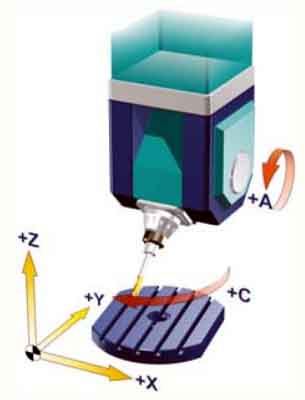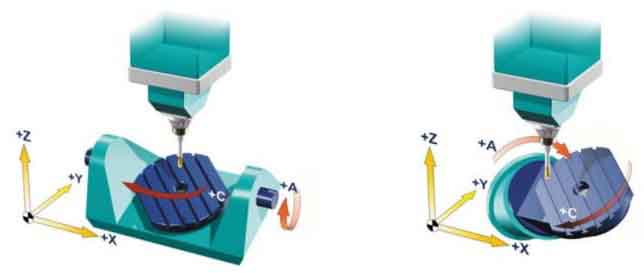Se on epäeettistä “puhua tarkkuudesta ilman varsinaista CNC-työstökonetta”. Jos niin sanotaan “viisiakselisen CNC-työstökoneen tarkkuus on varmasti suurempi kuin kolmiakselisen CNC-työstökoneen”, sitten se on kokonaan paperilla. On täysin mahdollista, että huippuluokan kolmiakselisilla työstökoneilla on korkeampi työstötarkkuusindeksi kuin tavallisilla viisiakselisilla työstökoneilla.
3-akselinen työstökone sisältää kolme lineaarista akselia, X, Y, ja Z, and its structure is relatively simple. During the processing of the 3-axis machining center, the direction of the tool axis will not change, the motion mode is also limited, and the programming is relatively simple.
On the surface, a 5-axis machine tool has two more rotation axes than a three-axis machine tool. Tuo on, in addition to the three linear axes of X, Y, ja Z, a 5-axis machine tool also includes two of the A, B, and C rotation axes around the three linear axes of X, Y, and Z respectively. Mainly include the following combinations:

5-axis single turntable type – 5-axis single pendulum head type

5-akselin kääntyvä päätyyppi (vasemmalle) ja 5-akselinen kallistettava kääntöpäätyyppi (oikein)

5-axis swivel type (vasemmalle) and 5-axis tilt swivel type (oikein)
The “5-axis tilting head” mentioned in the figure means that there is a rotating axis that is not perpendicular to the three linear axes, which is relatively rare. Its motion relationship is more complicated, but its structure is relatively compact, and its dynamic and static rigidity is better.
The difference between three-axis and five-axis is mainly reflected in the processing capacity. A five-axis machine tool can do the work of a three-axis machine tool, but the three-axis machine cannot complete the work of a five-axis machine tool. This shows that the existence of two rotating axes gives the five-axis machine tool stronger processing capabilities.
The advantages of the five-axis are mainly reflected in the following points:
1. Reduce the number of clamping. Due to the existence of two rotating shafts of the five-axis machine tool, the tool can approach the workpiece from any direction, and one clamping can realize the processing of all surfaces except the mounting surface. “Reduce the number of clamping times” can be described as two goals for the pursuit of high-efficiency and high-precision machining. Toisaalta, reducing the number of clamping times can save time, reduce the labor intensity of workers, and improve processing efficiency;
Toisaalta, it is possible to minimize possible errors caused by clamping and ensure processing accuracy.
2. Maintain the best cutting condition of the tool. Due to the use of a five-axis machine tool, the tool can approach the workpiece from any direction, so that the tool can cut the workpiece at the most appropriate angle. It can also improve processing efficiency and processing quality.
3. Effectively avoid interference between tools. Also because of the existence of two rotating axes of a five-axis machine tool, the tool can approach the workpiece from any direction, making the processing path flexible and changeable. Can effectively avoid the interference problem in the processing process.
4. Shorten the development cycle. This is also the effect that is naturally achieved after the quality and efficiency are improved.
 English
English العربية
العربية 中文(漢字)
中文(漢字) Čeština
Čeština Dansk
Dansk Nederlands
Nederlands Suomi
Suomi Français
Français Deutsch
Deutsch Italiano
Italiano 日本語
日本語 ಕನ್ನಡ
ಕನ್ನಡ 한국어
한국어 Português
Português Русский
Русский Slovenčina
Slovenčina Español
Español Svenska
Svenska Türkçe
Türkçe

